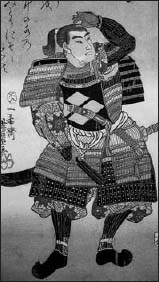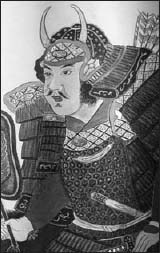
It is no enviable task to inherit the reputation of a father who has become a legend in his own lifetime, yet this was the burden placed on the shoulders of Takeda Katsuyori following the death of Shingen in 1573. Takeda Katsuyori was born in 1546, at the time when Takeda Shingen was expanding his territories from Kai into Shinano province. In 1544 Shingen had defeated in battle a local daimyô called Suwa Yorishige and then forced Yorishige to commit suicide following a humiliating and spurious peace conference. Yorishige had a 14-year-old daughter of great beauty, whose mother was Shingen’s younger sister. She had witnessed the defeat of her family and the judicial murder of her father at the hands of the Takeda, but then had had to suffer a personal anguish because Shingen became infatuated with her and took her – his own niece – to be one of his wives.
Takeda Shingen was so obsessed with the girl that his superstitious followers became alarmed and believed her to be an incarnation of the white fox-spirit of the Suwa Shrine, who had bewitched him in order to gain revenge. A fox assuming the form of a beautiful woman and making a man fall in love with her is a popular theme in Japanese folk belief. This ‘fox lady’ gave birth to Katsuyori in 1546 and died when her son was nine, so that when the destruction of the house came about through Katsuyori, wise old heads nodded, remembering the unhappy circumstances of his birth and the rumours about his magical mother.

A print depicting Takeda Katsuyori, who, in spite of all his earlier achievements, has gone down in history as the commander who was defeated at the battle of Nagashino. Katsuyori lived under the considerable shadow of his late father Takeda Shingen, and it may well have been a desire to emulate his father’s achievements that led to the campaign and battle of Nagashino.
As Shingen had doted on his mother, so he made Katsuyori his favourite son, to the extent of bestowing on him the character ‘Yori’ in his name, which was common in the Suwa family, rather than ‘Nobu’, which he bore himself (as Harunobu) and which his other sons also used. This always set him aside as rather special, and he became heir after the death in 1567 of his elder brother Yoshinobu.
Katsuyori was nonetheless a capable leader of samurai. He was schooled in the Takeda tradition of mobile warfare and knew how to handle the considerable striking force of the Takeda horsemen. He had fought well at Kawanakajima and had played a valuable part in the Battle of Mikata-ga-Hara, but when he succeeded his father he soon made enemies among Shingen’s old retainers. The ageing generals had considerable respect for Katsuyori as a soldier, but little else. These men, the surviving members of Takeda Shingen’s ‘Twenty-Four Generals’, possessed a wealth of experience in matters both military and political which they were more than willing to share with their new heir. However, Katsuyori proved unwilling to listen to their recommendations, preferring to make major policy decisions without undertaking any consultation with this key group of advisers. They had urged a defensive and consolidatory strategy following Shingen’s death, but this advice was completely ignored. As a result, the decisive move by Katsuyori to invade Mikawa province was taken against the recommendation of the men who had to follow him into action.

Oda Nobunaga, from a painted hanging scroll in the Okumura mansion, Inuyama. The battle of Nagashino in 1575 is Nobunaga’s greatest victory. It was a triumph both for his skills as a general, and his ability to learn from previous mistakes. His experience from the long campaign against the monk fanatics of the Ikkô-ikki at Nagashima and the battle of Mikata-ga-hara in 1572 are both evident in the approach he took to the challenge of the Takeda cavalry at Nagashino.
Like the Takeda, Oda Nobunaga was served by a handful of very able generals, but in his case there was considerable mutual respect. By the time of the battle of Nagashino Oda Nobunaga had become established as one of the finest leaders of samurai that Japan had ever seen. He had been born in 1534, and had inherited his father’s domains at the age of 15. He was bold and resourceful, and had the ability that was lacking in Takeda Katsuyori to benefit from the advice and experience of others. He had learned this the hard way when one of his retainers committed suicide in protest at the young lord’s earlier attitude. The battle of Okehazama showed his military genius. This victory over the Imagawa had come about through an appreciation of a military situation and a rapid response. Reliable intelligence had come to him that the Imagawa army was resting in a narrow gorge and celebrating the fall of one of Nobunaga’s castles. Realising that they would be off guard Oda Nobunaga led his men round in a surprise attack and took advantage of a sudden thunderstorm. His subsequent victories showed the same combination of careful planning and rapid execution, but he was also wise enough to realise that he did not have the power to defeat major enemies acting alone. The battle of the Anegawa, in 1570, although planned and controlled by Oda Nobunaga, depended for victory on his allies the Tokugawa.
Oda Nobunaga also possessed a great streak of ruthlessness. Frustrated by his inability to crush the militant Buddhist peasant armies of the Ikkô-ikki, Nobunaga demonstrated his force to them by destroying a soft target, the ancient monastic complex of Mount Hiei, near Kyoto, whose ‘warrior monks’ had supported the Ikkô-ikki. Tens of thousands of people were slaughtered and the entire monastery was burned. Ironically, Nobunaga owed the monastic armies a great debt of gratitude, for it was they who had taught him to be flexible in his fighting techniques. Nobunaga’s great strength was an appreciation of the most effective way in which firearms could be used, a lesson he had learned at the hands of the Ikkô-ikki. His position at the centre of power in Japan also enabled him to be at the forefront of military technology, and his links with Portuguese traders and his tolerance of Christianity gave him better access to European military hardware than many of his contemporaries, including the Takeda.
Oda Nobunaga’s ally Tokugawa Ieyasu, who was born in 1542, had learned the virtues of patience and loyalty through long years as a hostage of the Imagawa family. The death of Imagawa Yoshimoto released him from this burden, and he began applying himself to consolidating and defending his territory of Mikawa province, to which he eventually added neighbouring Tôtômi. By the time of the battle of Nagashino Ieyasu had matured from a spirited and sometimes reckless leader of samurai to a careful and intelligent general. At the battle of Azukizaka, in 1564, he had led his followers into battle, receiving spear cuts and bullet wounds. By 1570, at the battle of the Anegawa, he was controlling the Tokugawa army through a well organised battlefield communication system and was defended by a devoted bodyguard unit.

Tokugawa Ieyasu, as depicted on a painted scroll in the Nagashino Castle Preservation Hall. The Tokugawa held a strategic position between Oda Nobunaga and Takeda Katsuyori, and it was a raid by the Takeda on to the Tokugawa territories that precipitated the siege and battle of Nagashino. The Okudaira family, who defended Nagashino, were retainers of the Tokugawa who had once been forced to fight for the Takeda.
In 1572 Ieyasu narrowly avoided a crushing defeat when the Takeda invaded his territories and fought him at Mikata-ga-hara. The return of the Takeda in 1575, led by Takeda Katsuyori, placed Ieyasu once more in the firing line. Here his diplomatic skills in securing the continued support of Oda Nobunaga, who was not directly threatened by Katsuyori, proved as important as his military ones. All in all at Nagashino, Tokugawa Ieyasu was to show the qualities of generalship, diplomacy and good judgement which were ultimately to give him the supreme prize in Japan when he was proclaimed Shogun in 1603.
Nagashino castle was defended against the Takeda assault by Okudaira Sadamasa (1555-1615), a very capable soldier who was familiar with the territory and supported by a loyal and equally brave garrison. His appointment to the post was itself a challenge to Takeda Katsuyori. The Okudaira were a Mikawa family and were originally retainers of the Tokugawa, but had been forced to join Takeda Shingen. The Takeda can never have been very sure of their loyalty, because Sadamasa’s wife and younger brother were kept as permanent hostages in the Takeda headquarters in Kofu – hostage-taking, which was often done voluntarily as a means of assuring one’s loyalty to the overlord, was a very common arrangement in 16th century Japan.
With the death of Shingen in 1573, Okudaira Sadamasa decided to rejoin the Tokugawa, and marched his men out of the castle of Tsukude, which they had garrisoned on behalf of the Takeda. When news of this betrayal reached Takeda Katsuyori, he had Sadamasa’s family crucified. The result was to make the Okudaira into bitter enemies of Takeda Katsuyori, and when Tokugawa Ieyasu was looking for a retainer to place in charge of the strategic castle of Nagashino, which controlled movements into Mikawa from the Takeda territories, the appointment of Okudaira Sadamasa was a guarantee of determined resistance should the two sides ever meet in conflict.